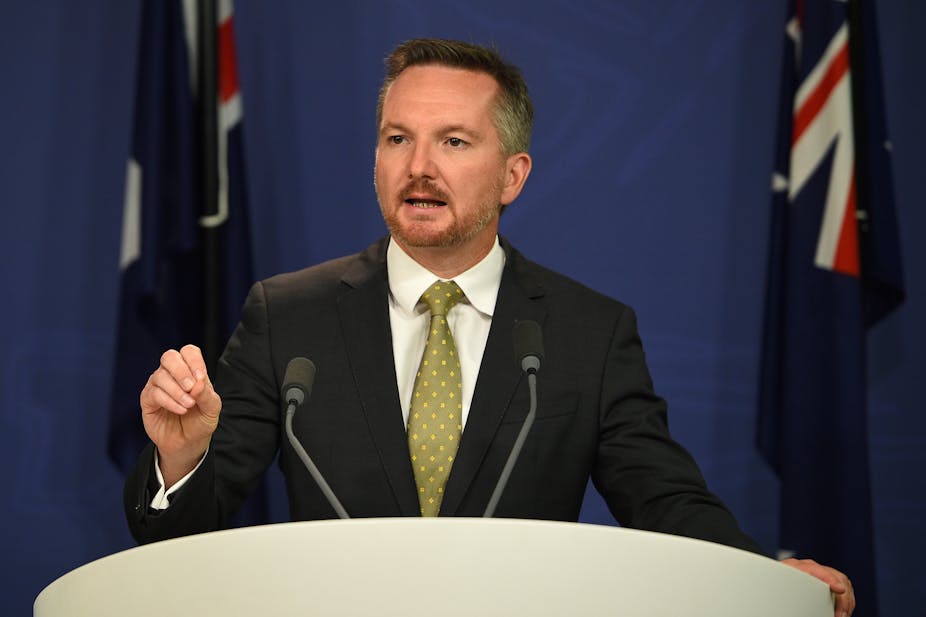Since the election, this government has had spending as a percentage of GDP at GFC levels. -– Shadow treasurer, Chris Bowen, media release, February 17, 2016.
During an election year, the focus is once again on the federal budget deficit. According to the most recent estimate in the government’s Mid-Year Economic and Fiscal Outlook (MYEFO), the deficit is estimated to be around A$37.4 billion for 2015-16.
One of the main questions is whether the current and forecast deficits are due to not enough tax revenue or too much spending, or both.
Labor’s shadow treasurer, Chris Bowen, told journalists that the government has had spending as a percentage of Gross Domestic Product (GDP) at global financial crisis (GFC) levels since the last federal election, which was in 2013.
Is that right?
Checking the source
When asked for official data to support his assertion, Bowen’s spokesman referred The Conversation to the MYEFO 2015-16, saying:
Here’s the official data for the purpose of comparison.
MYEFO 2015-16 (most recent data available)
Payments as a % of GDP
- 2009-10: 26.0%
- 2014-15: 25.6%
- 2015-16: 25.9% (estimate)
Those numbers are found in Table D1 of the MYEFO, which show general government cash payments as a percentage of GDP. Here’s how those figures look in a chart.
Bowen’s spokesman also referred The Conversation to a September 2015 interview in which treasurer Scott Morrison said that:
… we’ve got 26% or thereabouts of GDP of government expenditure. Now that is at the level of what we were at in the GFC.
Cash payments vs expenses
If you’re using the cash payments data in Table D1 of MYEFO, then Bowen’s statement is in the right ballpark – as long as you’re comparing with 2009-10 spending to represent “GFC levels”.
Bear in mind, though, that cash payments for the current financial year are an estimate only. Pedants will also note cash payments did, in fact, drop slightly as a percentage of GDP in 2014-15.
And as this previous FactCheck on government spending explains, it may be better to measure expenditure by checking the expenses data in Table D6 of MYEFO. That data shows expenditure when the expense occurs rather than when the cash payment is made (which is what Table D1 shows).
The expenses data detailed in Table D6 of MYEFO show expenses as a percentage of GDP as follows:
Still, Bowen’s statement is broadly correct – as long as you remember that the 2015-16 figures are an estimate only and you take 2009-10 as your reference point for “GFC levels”.
What do we mean by “GFC levels”?
The global financial crisis began in late 2007 and continued throughout 2008. A literal interpretation of Bowen’s statement could compare current government spending with spending levels in 2007-08, when the GFC was beginning and when expenses as a percentage of GDP was at 23.8%.
The effects of the GFC really began to take hold in late 2008-09.
Former prime minister Kevin Rudd launched the A$42 billion Nation Building and Jobs Plan in February 2009, and by 2008-09 expenses as a percentage of GDP was at 25.8%.
In other words, both Bowen and Morrison have compared current expenditure with a period of time in which the federal government was spending heavily in an effort to stimulate the economy in a time of global crisis.
The economic context
While comparing spending between years is important, it can be a misleading snapshot when viewed without further context.
It’s worth noting that current government spending is, in part, due to commitments and policies of previous governments. The Coalition government is, to some degree, locked in to policies that began under their predecessors, such as the Gonski education funding agreements, the National Disability Insurance Scheme and the National Broadband Network.
The 2015-16 Budget also includes interest repayments of A$11.166 billion on government debt that resulted from the huge increase in government borrowing to fund the previous government’s stimulus spending.
More broadly, the Australian economy has been growing since the 2013 federal election, but at a slower rate than its long-term average rate of economic growth.
This means that the unemployment level has been higher recently than it was during the strong growth years. That reduces tax revenue for the government and means the government has to spend more on unemployment benefits and concessions.
But the economy is growing – the most recent annual figure from the Australian Bureau of Statistics puts economic growth at 2.3%. This compares to 0.3% during the financial year 2008-09 – the worst growth year following the global financial crisis (GFC).
Verdict
Chris Bowen’s statement that government spending as a percentage of GDP since the last federal election is at GFC levels is correct – if you define “GFC levels” as 2009-10. This is the year that GFC spending programs were at their largest.
However, it’s important to note that government spending in part reflects the policy commitments and borrowings of previous governments. – Anne Garnett
Review
The author’s arguments are correct. The statements around the economic context are very relevant here. If we adjust for the state of the business cycle (which is tricky to do) and for interest, then it could be argued that spending is down. But with debt up, interest payments will be up for a while. So if we really want to tackle deficit and debts, then we need to get other spending under control or raise revenue. – Mark Crosby

